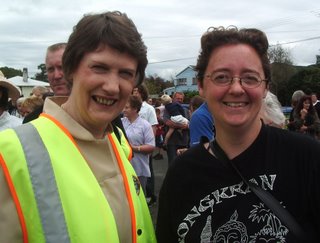So although I regard politicians with a healthy measure of distrust, I couldn't help but be impressed at the sheer casual approachability of New Zealand Prime Minister Helen Clark, who fronted up to a small town gathering this weekend and got straight in amongst the crowd to chat, shake hands and have her picture taken.

The occasion was the 100th anniversary of the opening of the railway line to Waihi, on the Saturday of the Easter long weekend. We were in the vicinity having gone down to stay overnight at Rochelle's parents' new home on the outskirts of Thames (on the Coromandel Pennisula). Reading in the local paper that there would be steam trains running between Waikino and Waihi through the Karangahake Gorge over Easter, we were there like a shot. Far from being your typical anorak-clad trainspotter, I nonetheless have a weakness for steam trains.

The railway line between Waikino and Waihi is about 7km long and is run as a tourist attraction by a railway restoration society. Normally they operate a diesel engine, but for the 100th anniversary celebrations, a couple of small steam engines were on loan from MOTAT (Museum Of Transport And Technology) in Auckland.
We'd seen in the paper that the Prime Minister woulds be there to give a speech but I didn't pay this much attention. We were waiting on the station platform at Waikino when Helen Clark showed up with her husband and sister to join the rest of the passengers. No pomp and ceremony, no special treatment. Just three people in casul clothing ready for a trip on a steam train.
The train was fairly full, and the main crowd were waiting at Waihi, the other end of the line. We disembarked and joined what was a relatively small group of maybe two or three hundred people. Helen Clark moved effortlessly through the crowd, saying hello to everyone and shaking hands. Rochelle was keen to get her photo taken, so we moved in and soon got our chance. Rochelle got to shake Helen Clark's hand and exchange a few words while I took a couple of photos.

Later on Helen Clark gave a speech about the history of Waihi and the railway, and then after more meet and greet, she prepared to leave by car. Most of the crowd who were not making the return trip on the train had dispersed by this time.
I happened to be standing not far away from a mother was trying to help out her young son with his shoelaces which had become tangled in a tight knot. She wasn't having much luck and the boy was a bit tearful. Suddenly Helen Clark darted over and was down on her hands and knees trying to work the shoelaces free. It took a while but eventually she managed it and then retied the boy's laces for him. The mother was understandably deeply impressed to have the PM helping out with her son.
Great piece of PR, demonstrating that our Prime Minister is in touch with the little people, and win a bunch of Labour votes with the locals, right? The thing is, there were no reporters, no camera crews about to record this moment and most people didn't even notice what she was doing. I was probably one of only a very few people there who saw it happen.

The train ride back to Waikino was spectacular - we rode in the open truck with the steam and soot blowing in our hair as the train charged down the line. The railway line follows the main road for most of its length so we had a great time exchanging waves with car passengers as they passed us.
An excellent day out!

